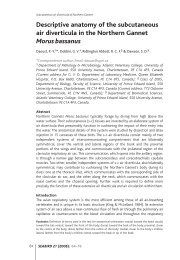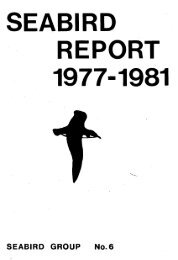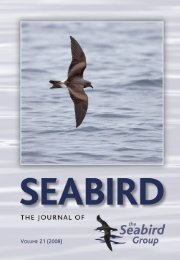You also want an ePaper? Increase the reach of your titles
YUMPU automatically turns print PDFs into web optimized ePapers that Google loves.
192 W.R.P. BOURNE & K.E.L. SIMMONS Atlantic <strong>Seabird</strong>s 3(4)<br />
[Table 2 continued]<br />
Birds and cetaceans seen per hour between 10-20°S and 8-21°W<br />
Month Aug Sep <strong>No</strong>v Jan Feb Apr May Total<br />
Hours 3 5 4 5 11 2.8 11.5 42.3<br />
Bulwer's Petrel<br />
Bulweria bulwerii 0.25 0.09 2<br />
Great Shearwater<br />
Puffinus gravis 0.09 1<br />
Madeiran Storm-petrel<br />
Oceanodroma castro? 0.09 1<br />
Black-bellied Storm-petrel<br />
Fregetta tropica 0.09 1<br />
Yellow-billed Tropicbird<br />
Phaethon lepturus 0.25 1<br />
Large whale sp 0.40 2<br />
Total 0 0.40 0.50 0 0.18 0 0.17 8<br />
Some identifications may be uncertain; thus Wilson's and Madeiran Storm-petrels may have been<br />
identified as Leach's, which certainly come on board ships much more often (Bourne 1992). It is<br />
also uncertain if the few large skuas catharacta sp. were C. skua, C. antarctica and its allies, or C.<br />
maccormicki, but all three smaller skuas Stercorarius sp. have been reported, S. parasiticus in<br />
<strong>No</strong>vember and February, S. pomarinus in February, and S. longicaudus in April. Arctic and possibly<br />
other terns also appear to stage in this area on migration. <strong>The</strong> cetaceans included Sperm Whales<br />
Physeter catodon in January, a Sei Whale Balaenoptera borealis and other unidentified rorquals in<br />
February, a Bryde's Whale B.edeni in October, and unidentified smaller species, none seen around<br />
Ascension.<br />
THE DISTRIBUTION OF THE BIRDS AT SEA<br />
<strong>The</strong> long incubation shifts found for several Ascension seabirds (Moreau 1962-<br />
63) imply that they travel far to feed. Stonehouse (1962) suggested they may<br />
exploit enriched water to lee of the south-west African upwelling. This might be<br />
reinforced by the passage of mesoscale eddies of upwelling water raising<br />
nutrients and food from the thermocline along the northern border of the<br />
Benguela Current where it passes west out to sea around 20°S to become the<br />
South Equatorial Current (Diester-Haass 1985), in the way found along the Gulf<br />
Stream (Haney 1986). However, Rowlands (1992) and Barritt (1992) among<br />
others have failed to find many birds here.<br />
Oceanographic investigations, the presence of more bones and guano in<br />
the north, and the main direction of flight of the birds (Fig. 2) and their density<br />
at sea (Table 2) indicate that most birds may feed instead to the north of<br />
Ascension. Bourne (1955) has postulated that the Atlantic equatorial current








